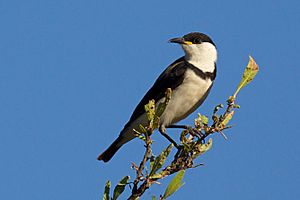Banded honeyeater facts for kids
Quick facts for kids Banded honeyeater |
|
|---|---|
 |
|
| Conservation status | |
| Scientific classification | |
| Synonyms | |
|
The banded honeyeater (Cissomela pectoralis) is a type of bird in the Meliphagidae family. It has a special narrow black band across its white chest. This bird lives only in tropical northern Australia.
Contents
What's in a Name?
The scientific name for the banded honeyeater is Cissomela pectoralis. A scientist named John Gould first described it in 1841. The very first example of this bird, called a 'holotype', is kept at a museum in Philadelphia.
This bird used to be in a different group called Certhionyx. But in 2011, scientists used new ways to study its DNA. They found that it belonged in its own special group, Cissomela.
Meaning of the Name
The name Cissomela was given by Bonaparte in 1854. It means "honey magpie" in Greek. The word kissa means 'magpie', which refers to the bird's black and white colors. The word mela means 'honey', because of what the bird likes to eat.
The second part of its name, pectoralis, comes from the Latin word pectoris. This means 'breast' or 'chest'. It describes the special band on the bird's chest.
How to Spot a Banded Honeyeater
The banded honeyeater is a small bird with black and white feathers. It has a clear black band across its white chest. Its back, tail, and head are black.
This bird has a long, curved beak and long legs.
Size of the Bird
- Its wingspan is about 12 to 14 centimetres (4.7 to 5.5 inches).
- Its beak measures about 14 to 18 millimetres (0.55 to 0.71 inches) long.
- The bird's body is about 11.5 to 13.5 centimetres (4.5 to 5.3 inches) long.
- It weighs about 8 to 13 grams (0.28 to 0.46 ounces).
Where it Lives and What it Eats
The banded honeyeater lives in tropical northern Australia. You can find it in grassy woodlands, open forests, mangroves, and Melaleuca swamps.
What's on the Menu?
This bird mostly eats nectar from flowers. It especially likes the nectar from eucalyptus trees. It also feeds on nectar from other open flowers like Grevilleas, paperbarks, and Bauhinias. Besides nectar, it also eats insects.
How it Behaves
Banded honeyeaters usually move around in pairs or small groups. However, if there are lots of flowers blooming, many of them might gather together. They often move from place to place to find the best blossoms.
Conservation Status
The banded honeyeater is listed as "Least Concern" (LC) on the IUCN Red List. This means that its population is stable and it is not currently at risk of disappearing.
Gallery
See also
 In Spanish: Mielero bandeado para niños
In Spanish: Mielero bandeado para niños




